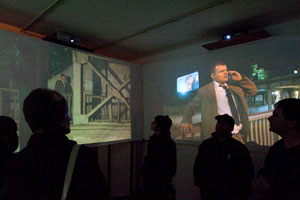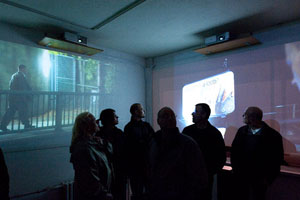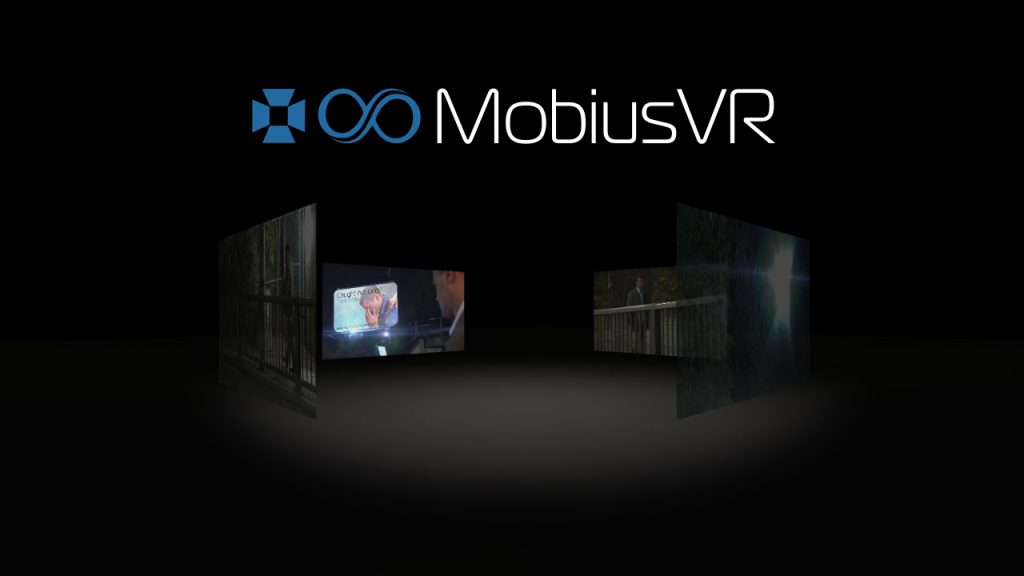
.jpg)
 A man trapped in a never-ending loop: a film shown on four screens arranged in a cube. Audiences, viewing from within, watch the looping film unfold. Each screen’s playback is delayed by 25% as the one next to it. The story temporally interacts with itself screen to screen.
A man trapped in a never-ending loop: a film shown on four screens arranged in a cube. Audiences, viewing from within, watch the looping film unfold. Each screen’s playback is delayed by 25% as the one next to it. The story temporally interacts with itself screen to screen.
The installation Mobius was mounted on October 1st, 2009 at Toronto’s Eaton Centre from 10AM to 9:30PM, and again on October 3rd, 2009, from sunset to sunrise the next morning as a part of Toronto’s annual Scotiabank Nuit Blanche in Cabbagetown.
Mobius, the installation, is an adaptation of a screenplay for linear short film written by Blair Renaud. The trapped man is played by Will Conlon. Produced, adapted, directed, filmed and edited by Jason Leaver. Music composed and performed by Adrian Ellis.
Composer Adrian Ellis wrote two insightful blog posts about his experience both as composer and observer, included below.
The Toronto Star’s Peter Goddard sited Mobius as one of his 16 must-see exhibits. You can read about it here.



Experience Mobius
Mobius has been “remounted” as a VR experience for the Oculus Go. Other platforms may become available in the future.
To download/install, please visit heybishop.itch.io/mobius or sidequestvr.com/app/1778/mobius-for-go
Watch Mobius
An alternate way to experience Mobius is by watching a 360° video using YouTube VR with your VR headset. If no VR headset is available, use any mobile device such as your phone with device’s YouTube App.
Watch flat-screen:
The following are blog posts written by composer Adrian Ellis, about his experiences crafting the music for this piece, and his experience of watching audience members interact with the immersive installation.
Solving the Mobius
by Adrian Ellis
I was recently asked to produce a music/sound score to an installation exhibited as part of Scotiabank’s Nuit Blanche 2009 in Toronto. Billed as ‘a free all-night contemporary art thing’, it transforms the city for a 12 hour period, as over 500 artists use public, gallery and ‘unexpected’ places to exhibit their work. If you’ve ever been, you know it’s a blast and absolute magic – and for me, getting to be a part of creating that magic was very exciting.
Jason Leaver’s “Mobius” is a mysterious piece – a video installation with four independent screens facing one another in a quadrant, each playing the same film footage at an offset of %25, and looping perpetually. The film itself follows a loose narrative, with no real beginning or end – a man is caught in a series of actions and events which lead him inexorably back to where he “started” – a sort of time/space shift where he begins his “loop” again. The real brilliance in the piece is how the film interacts with “itself”, via the screens and the offset. The character of the man is at times aware of and interacts with himself at different points in the loop – we are never sure if he is aware that it is himself. These points sync with one another in each screen; while one uses the phone, the other answers, while one calls out, the other can see and hear a shadowy figure across the way, calling out. Once the installation is running, it is a compelling concept – the character seems to ‘reach out’ out of the time-space of film, across the space of the exhibiting area and the viewer, to communicate with himself in another time.
My first challenge was to decide what the music was going to address: the character and his motivations, or the conceptual, formal aspects of the film? In the end I didn’t want to make too much of a statement on the piece itself, and rather treat it in a strictly formal way – enhancing the mood of the piece and offering moments of focus that aligned with the action while interacting with the other screens/events. I began by sketching out the action on paper, plotting out the events, and producing a “quad” time-line to see interactions and relationships. I liked the idea that to a certain extent, the final result would be left to chance, and so I began experimenting with sounds and processing. I responded to the feeling that I got from the footage: the grim, urban colors, the emptiness, sense of foreboding and confusion, and the eerie surrealist quality of the ’story’. To address the idea of temporal loops (real or imagined/metaphoric), I played with reversing some material, and gave the whole a reverb drenched, desolate quality. Heavily processed violas and oceanic guitars seem to moan and cry from afar, while the sound of an ancient ceiling fan I a sampled and shifted down 3 octaves, rumbles ominously but nearly imperceptibly below. Strange and alien motifs ring out in murky space, drawing the observers attention around the quadrant to correlating events. Once I laid up the first draft , I realized that even a small amount of material will sound tremendously busy and overwhelming when stacked 4 high, and so I had to revisit the material and cut out a large number of elements. Eventually, I found the balance that resulted in an extremely sparse track on it’s own, but worked when played in the quadrant.
Mobius revisited, and Nuit Blanche ‘09
by Adrian Ellis
In a previous post, I described my process in creating the music for Jason Leaver’s video installation, Mobius, which premiered at Scotiabank Nuit Blanche on Oct. 3rd. The experience of being a part of this project was fascinating on a number of levels that I felt were worthy of sharing.
Public Space
Before Nuit Blanche proper, Jason was invited to preview his work in a public setting, namely Eaton’s Center mall in downtown Toronto. In this environment, it was very interesting seeing people’s reaction to the work.
Context has such a powerful effect on how people view and respond to a piece. By taking it out of the gallery setting, I wondered: Do you get a much more natural and immediate reaction, without the anxiety or preconceptions of how art ’should’ be viewed?
Jason had used yellow tape to secure cables to the floor – these had the unintended appearance of police tape cordoning off a no-go zone. Many people approached the exhibit with genuine curiosity, but were reluctant to cross this invisible ‘threshold’. This was exactly the opposite of what Jason wanted, but luckily he was just the man to handle it. Jason fears approaching no one, and with big arm gestures and engaging banter would quickly usher these shy observes into the center of his piece, pointing out elements of interest and suggesting different ways to get the most out of the experience. His enthusiasm and willingness to explain without a hint of condescension was catching and inspiring. Jason is about as unpretentious as they come, and simply oozes pure joy about his work and people’s reactions. His love is a love of the work, not of what the work will get him. It’s not about him, it’s about the viewer’s experience. He is a brilliant ambassador to the world of art – when I saw how engaged and joyous the viewers were in their experience, I thought – this is it!
Interpretations come in many forms!
It was also very interesting to view the work in the context of a mall from an aesthetic and technical perspective. Already a surreal piece, it became even stranger when seen next to a Sears and trendy clothing shops. The bustle of the mall, the noise, and people’s surprise and wonder at this unexpected object all added to and changed it’s meaning. My own interpretation of the piece is that it works as a commentary on the modern cubicle dweller, the feeling that you are trapped by the forces of convention and commerce to perform the same actions perpetually, day after day. As a location then, a mall and it’s association with the cycle of work/spend/work/spend, is kind of perfect. When I asked Jason about the most unusual comment he received, he told me about a woman who was very offended and more or less yelled at him about “playing at being God”, and how could he keep this poor man trapped in this terrible loop? The suggestion that he could stop the cycle at any moment using a remote control was met by more righteous anger, as if it were being suggesting that, like Jesus, he was able to perform miracles. Blasphemy! Congratulations, Jason: you’re now ‘officially’ an Artist.
Ephemera
For my part, it was very interesting to be part of something where the work existed only for the short time it was installed and running. Sure, my music files still exist and can be played on any manner of system, but the ‘real’ work – Mobius – in it’s intended final form, exists specifically in it’s four screen projected state, with the sound played back by four independent speakers associated with each of the screens in the quadrant. The experience of standing in the quadrant, and how the music and visuals affect one another cannot be recreated in any other manner. So this was it – I would experience it for those short moments, and then it would fade to memory. The surprise of how the visuals and sound interacted was also a treat – there were elements I left to chance, and stuff that I had no way of properly previewing. In an age of the instant gratification of orchestral mock-ups and digital photos it was a delicious tease, and I did linger and savour it for much longer because I knew after this it would be gone, probably forever. This must be what composers must have felt like in the years before recordings – their orchestral works would be heard during rehearsal and performance, and not again until another concert could be mounted.
A full moon and Nuit Blanche!
What a vibe, what an energy! It was incredible to see so many people out wandering the streets and taking in the sights and sounds. It was a youthful, vibrant, excited, and positive feeling. After taking in a number of exhibits (which included people being suspended in folded pentagram cradles, a giant pool of vodka, and a midway of sorts with rides supposedly operated by ex-bankers), my wife, my friends Aaron and Goran and I finally found our way to Mobius at around midnight, which was situated in a gallery in Cabbagetown on the Eastern edge of Zone A. The small, single room space was stuffed to bursting with people, and a very satisfied Jason sat off to one side listening to the many conversations of observers as they discovered and interpreted the piece. The reception it was getting was fantastic – people ‘got it’ and got into it. I think the fact that there was a mystery unraveling before their eyes was a particularly attractive. I enjoyed the somewhat claustrophobic but intimate setting, and having the piece projected on fabric added a kind of mysterious ephemeral quality. I was surprised to find that I felt the sound at the previous installation was better; not in terms of quality, but in terms of consistency. The music and the film are each the same for each of the four screens, but at an offset. When the music played on 4 identical speaker systems, this sense of the material being the same but playing with and against itself was more clear. But this was a small technicality and certainly did not detract from the piece on whole. A great moment was when a group of film students enthusiastically told Jason of how inspiring the experience was – they were genuinely excited. When Jason asked one about her background, she stammered a little, and Will (the actor in the film) came up behind Jason and teased: “He’s just a man”. Industry accolades are great, but there is a special thrill when a student of your craft is excited by your work.
In the end, I feel very lucky to have been part of this project. Firstly, because it was a successful work and deeply satisfying for me, but also because I got to see it in a number of contexts and iterations, which was terrifically interesting. I also got to go from being a fan of Nuit Blanche to an active participant, and got to enjoy the feeling that I had helped in making someone’s night just a little more magical. It was a memorable evening that even the rain and a lingering cold couldn’t dampen, and I am already counting the days until next year.
